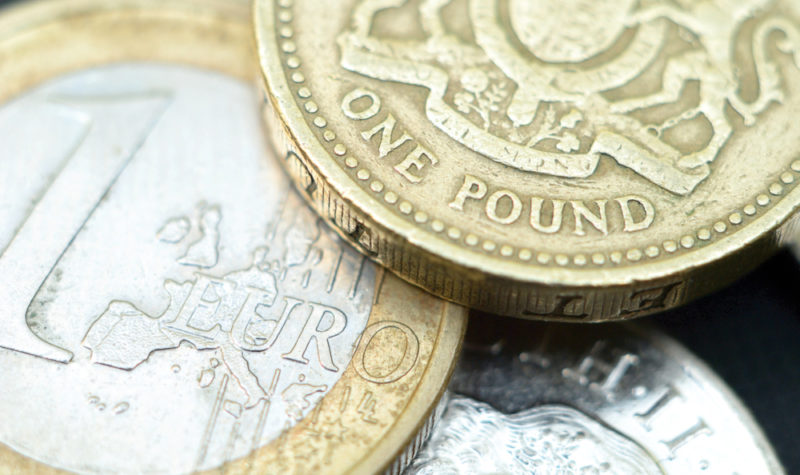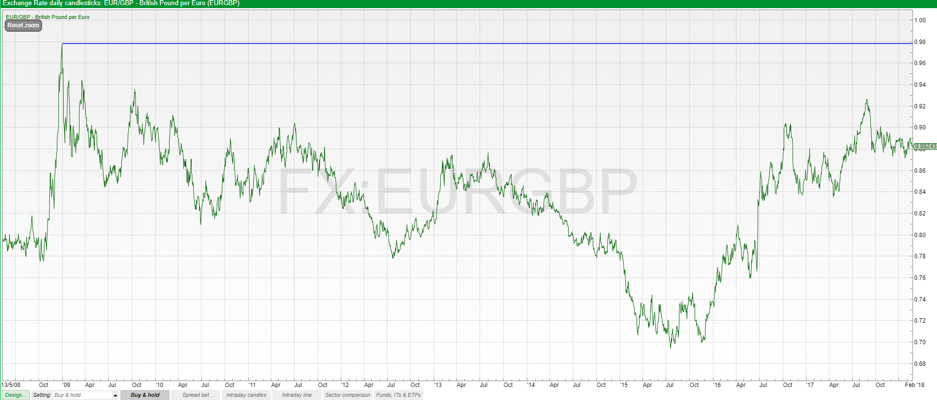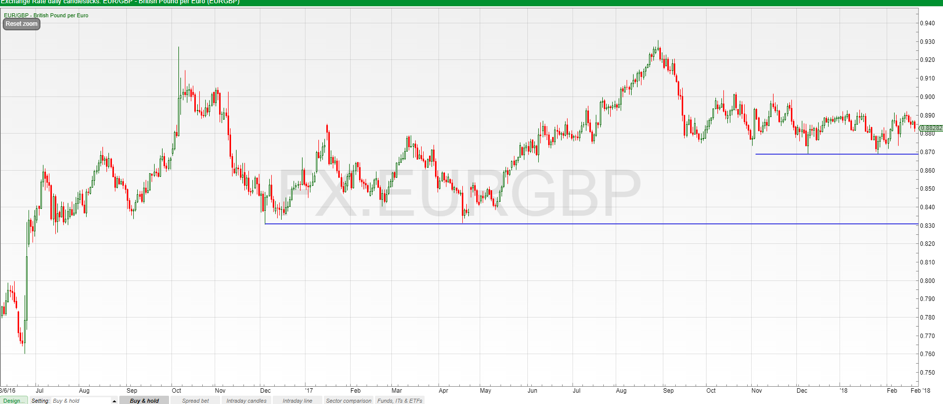Is the euro set to dominate the pound?

Given the fact that you can barely watch the news today without the “B” word rearing its head, I thought it could be timely to take a look at the fortunes of the pound versus its nearest currency neighbour, the euro. The market convention is actually to quote this the other way around to what we are used to seeing in the likes of Thomas Cook in the summer. So, from a trading point of view everyone sticks with euro/pound (EUR/GBP) – let’s just look at the bigger picture first.

Although much was made last summer of the strength seen in the euro against the pound – it traded as high as the 0.92 area (one euro would buy 92p) – it has of course been even stronger in the past. If we go back to the dark days of the financial crisis, when there were real worries about the impact of bank failures on the UK economy, one euro would have bought 98p back then. Many expected it to surpass the £1 mark but, as so often happens whenever we get to an extreme of sentiment where the majority of market participants think that a certain move is almost a sure thing, it was time to bet the other way. By 2015, the euro had lost a lot of ground and was worth just under 70p.
That’s the history lesson out of the way – so what are the main factors to watch that could push these currencies around?
Hurdles for the pound
It’s simple – it’s mostly down to how well or badly the Brexit negotiations go. At the moment, the wider market does seem to be taking a mildly optimistic view, with some of the very pessimistic outlook statements made in 2017 having to be revised. This is particularly true when it comes to the pound/US dollar (GBP/USD), for example, with the pound having clawed back a significant chunk of the losses seen since the June 2016 referendum.
Brexit is the big one – but also the Bank of England will play its part. It has already warned that interest rates may end up rising faster than it first thought if inflation starts to pick up. A higher base rate would usually be positive for the pound.
Courtesy of these two factors, the pound does have a slight tail wind at the moment – but an indiscreet statement from a member of the government could take that away very quickly.
Hurdles for the euro
This is something of a more complex argument. Of course, the Brexit negotiations come into play – no side really wants a bad outcome that could end up stifling trade between the two economic zones. But understandably for now the main focus is the effect all this has on the pound.
If you take even a passing interest in markets, you will know that plenty of central banks have had some sort of stimulus programme in recent years – the likes of quantitative easing for example. If we refer to this by the somewhat flippant term of “printing more money”, this clearly can weigh on the currency affected. The European Central Bank (ECB) continues to scale back the support it has given since the financial crisis, but for the moment at least there is no sign that this is going to completely end.
The pound does have a slight tail wind at the moment – but an indiscreet statement from a member of the government could take that away very quickly.
One of the reasons for the reluctance to stop is that the rate of inflation in the eurozone remains relatively low, whilst other regions are gaining ground. European inflation fell in January to 1.3%, compared with a UK rate of around 3%. This does suggest that the ECB would also be in no hurry to raise rates just yet, so it seems unlikely the euro is going to get a boost here in the short term.
There is also the question as to whether the euro is somewhat overstretched across the board, when compared to other currencies. Since the beginning of 2017, it has risen by 20% against the US dollar. Admittedly last year was a terrible year for the American currency and this year hasn’t started much better. But it would be surprising to see another runaway year – and the pound by comparison has fared less well, once again of course following the referendum.
Recent EUR/GBP performance

The last five months have not been the most exciting. You can see that something of a floor has formed in the 0.8700 area for EUR/GBP. There is a clear appetite to be a buyer of the euro on dips back to here, but then little in the way of pushing that risk out much higher. Rallies have been stalling in the 0.9000 area, making for a very quiet market.
The real trigger for weakness in EUR/GBP would be a slide though that 0.8700 zone. This could pick up the pressure on the euro and target a return back to the 0.8300 lows from late 2016 and the first half of 2017.
Don’t miss David’s next piece in the next edition of Master Investor Magazine – Sign-up HERE for FREE
Given the ongoing Brexit discussions, it shouldn’t be too surprising that EUR/GBP has carved out this somewhat uninspiring trading range in recent months. But it does look as if the markets at the moment do not think this is going to be a disaster for the pound – EUR/GBP has fallen back by around 5% from those August highs.
It does feel as if the risk here is leaning towards the euro falling. Taking Brexit out of the equation, ongoing stimulus by its central bank is going to keep some pressure on euro gains. That lack of inflation compared to the UK means that the ECB is not on the same path of rate rises as the Bank of England. At the moment it seems like markets are waiting for some sort of breakthrough to really wake up trading in EUR/GBP – but don’t be surprised if that ends up being a surprise to the downside, and we see the euro lose some ground against its cross-Channel neighbour.
Comments (0)